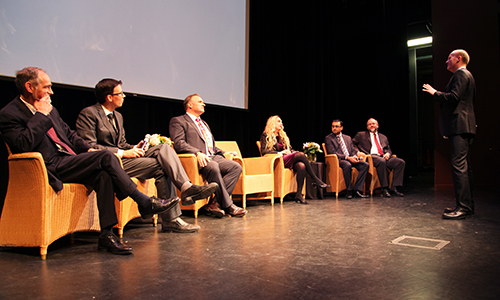 December 18, 2015 — A one-hour talk on the future of health, robotics and energy could have easily been mistaken as a talk on science fiction: from replacing body parts with living tissue that grows as you age, to creating robots that help the elderly get ready in the morning, to regenerating a waste product like CO2 into a future-fuel for airplanes.
December 18, 2015 — A one-hour talk on the future of health, robotics and energy could have easily been mistaken as a talk on science fiction: from replacing body parts with living tissue that grows as you age, to creating robots that help the elderly get ready in the morning, to regenerating a waste product like CO2 into a future-fuel for airplanes.
But what people thought was science fiction 20 or 30 years ago are now today’s innovations, whether it’s wireless technology or virtual reality headsets, just to name a few. U of T mechanical engineering professors Craig Simmons (MIE, IBBME), Goldie Nejat (MIE) and David Sinton (MIE), and their industry collaborators, hope to revolutionize the next 20 or 30 years with research in their respective fields: health, robotics and energy.
The panel discussion, ‘Your Future, Our Future,’ – held at the Isabel Bader Theatre on December 4 – was a culmination of a year-long celebration by the Department of Mechanical & Industrial Engineering to commemorate 125 years of mechanical engineering at U of T. The event was an opportunity to welcome the Toronto community together to learn how mechanical engineering research can be applied to industry, and more importantly, how this research will make a positive impact on society.
The talk was moderated by University Professor Ted Sargent (ECE) and also featured industry panelists Dr. Mitesh V. Badiwala, surgical director of the Heart Transplant Program at the Peter Munk Cardiac Centre; Ted Maulucci (MechE 8T9), Chief Information Officer of Tridel Corporation; and, Chris Twigge-Molecey (MechE MASc 6T9, PhD 7T2), Senior Advisor at Hatch Limited.
“Craig, if you were successful [in your bioengineering research], in five or 10, 15 years, how could the experience with a patient be different?” asked Sargent, kicking off the talk.
“Babies born with a congenital heart defect, they often require surgery early in life,” explained Simmons, who is the Canada Research Chair in Mechanobiology, and the scientific director of the new Translational Biology and Engineering Program (TBEP) at Ted Rogers Centre for Heart Research.
“The materials used to repair that valve are things like fabrics, synthetics. Those don’t last a lifetime, so a baby might have to have multiple operations. What we’re imagining is: what if instead of doing that, we could take stem cells from the umbilical cord and combine it with a biomaterial and use mechanical forces to exercise that growing tissue to become a robust heart valve tissue, which could be used instead of synthetic material.”
This work closely relates to a future Dr. Badiwala hopes to see: minimally invasive valve replacement technologies. “The area of heart surgery that I’m interested in, that will totally revolutionize heart care, is heart-replacement technology and advancements in transplantation,” he said. “Hopefully in my lifetime, there may come a day where we take a diseased heart out of a patient, replace it temporarily with a pump but then repair their own heart outside of their body and then re-transplant it.”
Sargent then asked Nejat to describe how robotics is helping to answer health and social questions related to aging. According to Statistics Canada, people aged 65 and older will account for almost a quarter of the population by 2051.
“We’ve been focusing on developing robots that can live in your home and help you with activities of daily living as you age, like prompting you through steps of getting up in the morning, making a meal and eating it,” said Nejat, the Canada Research Chair in Robots for Society and the director of the Institute for Robotics & Mechatronics.
“We’re also looking at using robots to provide simulation during leisure activities. A lot of older adults are isolated from their families, and that has negative impacts on your health. Our robots provide recreational activities that older adults can engage in, and through that, we improve their social and cognitive stimulation.”
On the topic of renewable energy, Sinton, who is MIE’s Associate Chair of Research and specializes in the study and application of small-scale fluid for use in energy systems and analysis, spoke on the challenges of a slow-moving industry and the future of renewable energy.
“I would think that energy companies must be so jealous of Facebook, because they can wake up and see a hundred thousand new users,” said Sinton. “The energy industry is resource intensive… it moves very slowly.”
“But renewable energy, that’s the future. We’re looking ahead at developing next-generation technologies, using renewable energy to take this waste product, CO2, and turning it into useful products, hopefully high-value products. The challenge [ahead] is turning CO2 into fuels that can go into airplanes and freighters. Those are exciting new areas that we’re working on every day.”
Sargent ended the hour-long lively discussion by opening the floor to audience questions. Those in attendance included fellow engineering researchers, alumni, staff, graduate students, industry representatives, hospital workers, high schoolers, and even younger students.
Craig Brown brought his two sons, aged 10 and 12. “My 12-year-old son, Aiden, he’s a budding engineer. He does really well in math and has a keen interest in how things are built and is always asking about how things will be built in the future,” said Brown. “So I thought this would be a good opportunity to bring them here and expose him to engineering and what the future holds.”
View more photos from the event.
Watch a clip from the talk below: